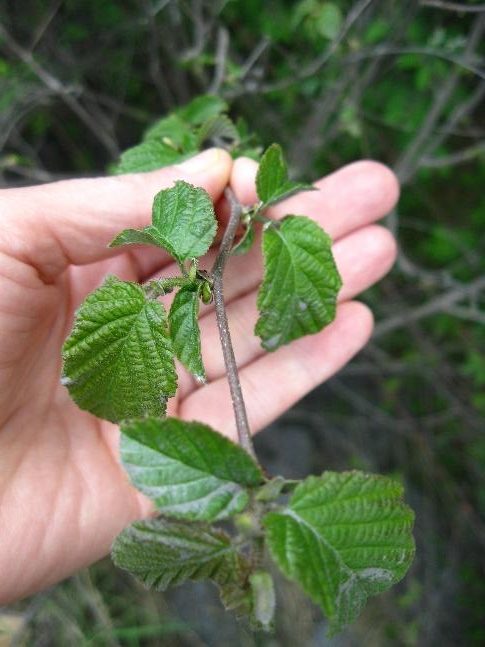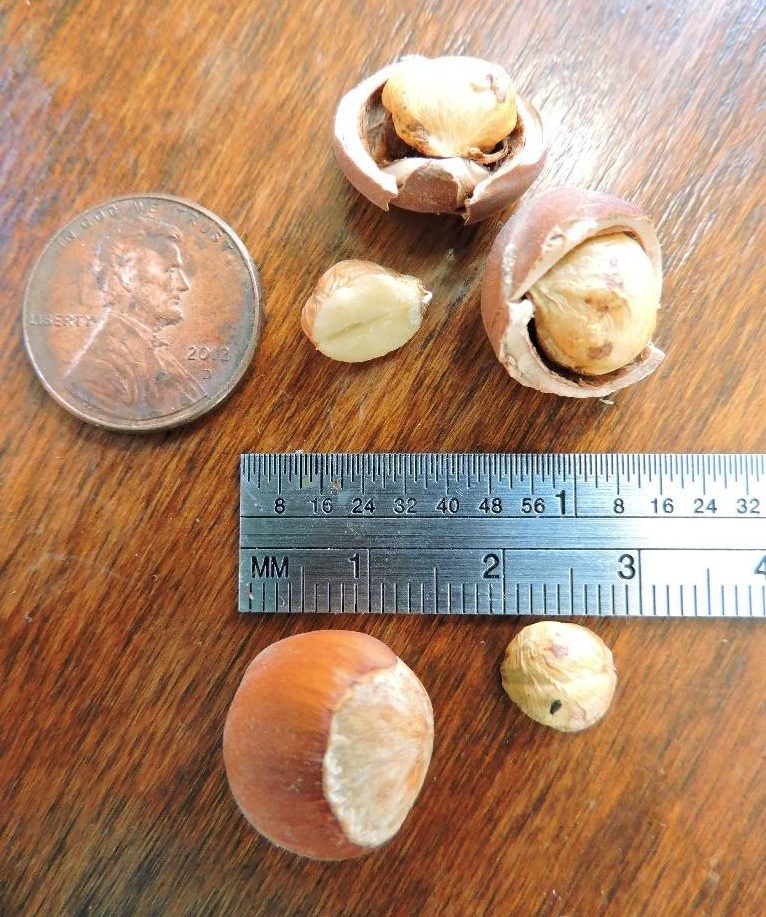Name: Hazel, American
Botanical Name: Corylus americana
Form: Shrub
Parts Used: Nuts, browse
Citation: Guenther, K. (2020, December 21) American hazel as wildlife food [Web log post.] Retrieved: supply the date, from http://wildfoods4wildlife.com
Getting Started
Hazelnuts—sometimes called filberts— are a wildlife favorite for many common mammals and some birds, especially game birds. Beaked hazelnut which grows in wet areas is especially loved by beaver, moose and snowshoe hare! While there are only two native species of hazel in Virginia, there are other domestic varieties. Though it takes a number of years to get them established before they produce nuts, hazel varieties are considered easy to grow in a wide range of conditions, so you can grow your own rather than forage for them in the wild and get as many as you want both for yourself and for the critters!
Betulaceae (Birch Family)
Coryloideae (Hazel Subfamily)
Corylus (Hazel Genus)
American hazel is more shrub than a tree, so it is easy to overlook it in a woodland area. They grow to about 10-15 feet tall. Like most shrubs, they have multiple trunks. Hazel grows colonially, so you find it in stands or colonies rather than as single shrubs.
The hazelnuts themselves are distinctive and easy to identify, but there are a few shrub look-alikes and name-alikes that you might want to study up on if you are going to try to identify the shrub without nuts. There is a hazel alder (Alnus serrulate) which has similar leaves, witch hazel (Hamamelis spp.) that has somewhat similar flowers and winter hazel (Corylopsis spp.) which looks pretty dissimilar all the way around to me. None of the look-alikes produce nuts.
| Common name | Virginia Corylus species | Origin | Rare Plant Status |
| American hazel | C. americana | native | Not rare |
| Beaked hazel | C. cornuta | native | Yes, in some states (not Virginia) |
Virginia Botanical Associates. (Accessed December 2020). Digital Atlas of the Virginia Flora (http://www.vaplantatlas.org). c/o Virginia Botanical Associates, Blacksburg.
USDA, NRCS. 2015. The PLANTS Database (http://plants.usda.gov, 27 November 2020). National Plant Data Team, Greensboro, NC 27401-4901 USA.

Flower Description: The male flowers of alder and hazel look very similar, sort of like a dangling section of pipe cleaner. Alder and hazel are in the same family: they are related. The female flowers of each are quite different, however. Alder female flowers are a stumpy, cone-like catkin, while hazel has a red spider-looking bloom (the flower’s stigmas) somewhat similar in shape to yellow witch hazel blossoms. Witch “hazel” is hazel in name only, not closely relate to hazel at all. The red female American hazel flowers appear in late winter and are wind-pollinated by the male flowers that grow on the same shrub.




Leaf Description: The leaves are described as double-toothed. I think of double-toothed leaves as being like a crosscut saw with big teeth alternating with smaller teeth. The leaves have sparse hairs on the face of the leaf as well as veins and stem. Even the twigs have hairs. The base of the leaf (stem end) is heart-shaped, the tip pointed.


Nut Size: The shell of the nut is encased in a flattened crepe paper-like husk wrapper that has shaggy edges. The hard nut hull within measures about ½ inch diameter and inside the hull are the nutmeats.



Harvest
| Jan | Feb | Mar | Apr | May | Jun | Jul | Aug | Sep | Oct | Nov | Dec | ||||||||||||||
|---|---|---|---|---|---|---|---|---|---|---|---|---|---|---|---|---|---|---|---|---|---|---|---|---|---|
| winter | winter | late winter | early spring | spring | late spring | early summer | summer | late summer | early fall | fall | late fall | ||||||||||||||
| nuts | x | x | x | ||||||||||||||||||||||
Is this a good enrichment item? Nuts are almost always good enrichment items because you can control how much work you want your patient to do to reach the reward. Hazelnuts can be offered fully in the husk, or you can remove the husk and just offer the nuts. You can even pre-crack the nutshells prior to offering for younger or weaker patients.
When to Harvest Nuts: Hazelnuts can be seen developing on the shrub by mid-July, but they are not ready for harvest until September here in Virginia. About the time the hazel leaves start to turn a coppery color in the fall, the nuts will start to fall to the ground over the course of a couple of weeks. Since wildlife really like hazelnuts, they will not last long on the ground. If you see nuts on the ground, a gentle shake of the shrub may bring down more for you to take.
However, hazelnuts will continue to ripen if you harvest them slightly early before they drop. When the outer husk just starts turning brown, you can harvest. If you try to wait until the husk is fully brown, the food may no longer be there! Once harvested, immediately spread the hazelnuts out on screen in a dark, warm, dry place indoors to dry and further ripen. In a couple of weeks, the outer husk will be crispy dry and you can remove the husks and just keep the nuts (still in the shell).
How to Store Nuts: In the shell (husk removed), hazelnuts can be stored at room temperature for several months. For longer, they can be stored in an airtight container like a canning jar in the refrigerator (still in shells) for up to a year. You can also remove the shells (hulls) and just store the nutmeats in an airtight container in the refrigerator or freezer.

Harvesting Hazel Browse
Browse as a term used on this website refers to the twigs and small branches, with or without leaves or needles, of trees, shrubs, vines and other woody-stemmed plants. Browse can also refer to bark, for the animals that gnaw on bark.
Shrubs cannot tolerate very much cutting and survive. The best time to harvest browse for the health of the shrub is late fall to winter, but that may not be when you need the browse. The best limbs to remove are ones that rub together and cause abrasions that can make the shrub vulnerable to insect damage. Or, cut branches that are overcrowded or hang low to the ground. Prune branches back to the base where the branch meets the trunk to minimize future insect damage to the shrub.
Dip pruning shears into a bleach-water solution (1:3) to minimize transferring tree diseases from one shrub to the next.
Place the cut end of the browse in a bucket of water as soon as possible after cutting- ideally taking a bucket of what with you as you harvest because the branch will start to close itself off the instant it is injured. Then keep them in water as much as possible prior to feeding, which ideally means even during transport. And keep cut browse in the shade.
Browse cuttings are best fed to animals right away, they do not store well for more than a day before the leaves start to wilt and dry out, especially if it is hot. Read more, at Cutting Browse.
Feed Hazel to:
hazelnut | (Corylus spp.) | browse/bark |
|---|---|---|
Beaver, American | Castor canadensis |
|
Cottontail, Eastern | Sylvilagus floridanus |
|
Deer, White-tailed | Odocoileus virginianus |
|
Elk, Rocky Mountain | Cervus elaphus |
|
Hare, Snowshoe | Lepus americanus |
|
Moose | Alces americanus |
|
Raccoon, Northern | Procyon lotor |
|
Squirrel, American Red | Tamiasciurus hudsonicus |
|
Squirrel, Eastern Fox | Sciurus niger |
|
Bobwhite, Northern | Colinus virginianus |
|
Grouse, Ruffed | Bonasa umbellus |
|
hazelnut | (Corylus spp.) | flowers/buds/catkins |
Grouse, Ruffed | Bonasa umbellus |
|
Grouse, Sharp-tailed | Tympanuchus phasianellus |
|
hazelnut | (Corylus spp.) | nuts |
Bear, American Black | Ursus americanus |
|
Beaver, American | Castor canadensis |
|
Chipmunk, Eastern | Tamias striatus |
|
Cottontail, Eastern | Sylvilagus floridanus |
|
Deer, White-tailed | Odocoileus virginianus |
|
Hare, Snowshoe | Lepus americanus |
|
Moose | Alces americanus |
|
Mouse, Common White-footed | Peromyscus leucopus |
|
Raccoon, Northern | Procyon lotor |
|
Squirrel, American Red | Tamiasciurus hudsonicus |
|
Squirrel, Eastern Fox | Sciurus niger |
|
Jay, Blue | Cyanocitta cristata |
|
Bobwhite, Northern | Colinus virginianus |
|
Grouse, Ruffed | Bonasa umbellus |
|
Turkey, Wild | Meleagris gallopavo |
|
hazelnut, American | (Corylus americana) | browse/bark |
Deer, White-tailed | Odocoileus virginianus |
|
Bobwhite, Northern | Colinus virginianus |
|
Grouse, Ruffed | Bonasa umbellus |
|
hazelnut, American | (Corylus americana) | nuts |
Beaver, American | Castor canadensis |
|
Deer, White-tailed | Odocoileus virginianus |
|
Moose | Alces americanus |
|
hazelnut, beaked | (Corylus cornuta) | browse/bark |
Beaver, American | Castor canadensis | strong preference |
Elk, Rocky Mountain | Cervus elaphus | strong preference |
Hare, Snowshoe | Lepus americanus | strong preference |
Moose | Alces americanus | strong preference |
Deer, White-tailed | Odocoileus virginianus |
|
hazelnut, beaked | (Corylus cornuta) | nuts |
Bear, American Black | Ursus americanus |
|
Squirrel, American Red | Tamiasciurus hudsonicus |
|
Turkey, Wild | Meleagris gallopavo |
|
Book References:
Elpel, T.J. (2013) Botany in a Day (APG). Pony, Montana: Hops Press, LLC.
Martin, A.C., Zim, H.S., Nelson, A.L. (1951). American Wildlife and Plants: A Guide to Wildlife Food Habits. New York: Dover Publications.
Scott, M. (2013). Songbird Diet Index. National Wildlife Rehabilitators Association, St. Cloud, MN.
Townsend, J. F. (2019, March) Natural Heritage Resources of Virginia: Rare Plants. Natural Heritage Technical Report 19-15. Virginia Department of Conservation and Recreation, Division of Natural Heritage, Richmond, Virginia. Unpublished report.
Online References:
USDA, NRCS. 2015. The PLANTS Database (http://plants.usda.gov, 27 November 2020). National Plant Data Team, Greensboro, NC 27401-4901 USA.
Virginia Botanical Associates. (Accessed December 2020). Digital Atlas of the Virginia Flora (http://www.vaplantatlas.org). c/o Virginia Botanical Associates, Blacksburg.

